As we celebrate our 25th anniversary, we’re taking a look back at the first issue of Kraków In Your Pocket in all of its absurdly outdated glory, and highlighting just how much our printed guidebook has changed over the years.
July 1999: The Way Things Were
Some of you might remember that back in 1999, also known as the end of the previous century, society was not nearly as global as it is today. Not only was the idea of taking a short holiday abroad not as common a practice, but Poland, like all of ‘Eastern Europe’ (as most called it back then), was still considered an ‘edgy’ place to travel. Those who did visit almost unanimously described the city as an ‘undiscovered gem,’ but were just as quick to remark about the lack of tourist infrastructure and appalling customer service as they were about the beautiful architecture. [In steps In Your Pocket and pretty soon the city is European Capital of Culture (2000), and Poland has joined the EU (2004). Huzzah.]

by turning them all into massive underground shopping malls.
In terms of content and design, the guide was a slightly more evolved permutation of the editorial model established with the first In Your Pocket guide, written for Vilnius in 1992. There were very few images and photographs, the few icons/symbols (or should we say ‘wingdings’?) that were used look hilariously archaic today, and the maps were almost unreadable.

Organised as more of a directory of alphabetical listings, much of the guide resembled a phonebook (remember those?), and it began with an encyclopaedic section on ‘Basic Data’ that included sections on Climate, Geography and Population. The guide then went on to a ‘Glossary’ section with short explanations under headings such as Electricity, Safety, Roads and Toilets. The need for such sections suggests just how much less often people travelled 25 years ago, and also how much more Poland was still perceived as an exotic and very foreign destination; the kind of place where travellers might require assurance or advice about such things as using restrooms.
A flip through the guide reveals many more examples of information that was deemed practical for tourists in 1999, but today seems completely obvious, unnecessary, absurd or simply head-scratching. Here are some of our favourites:
1) The Mysterious 'Business Discount'
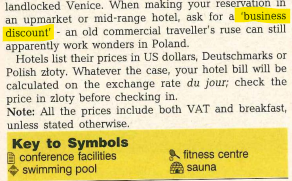
While we're here, let's take a moment to recognise these Hotel chapter symbols. Pioneers like igloo and the word 'pool' inside a black diamond broke down barriers for today's emojis to run through.
Other nuances of the 'Where to Stay' section include warnings about hostel curfews (p.15) and being hassled by grannies offering guestrooms as soon as you stepped onto the train platform (p.14). It's worth noting that accommodation listings occupied 6 pages of the guide, and they were not only important advertisers in early IYP guides, but also served as our distribution points. For this reason they remained a fixture of IYP guidebooks until 2020, despite online platforms like AirBnB and Booking.com making them utterly obsolete.
2) Reeboks, Rat Poison & Window Repair
If you wanted to know where to buy corsets, cat food, skateboards, scuba gear, neck-ties, perfume, ballet shoes, mousetraps, masks or gingerbread houses while in Kraków - this guide would tell you. In fact, the heading 'WHAT TO BUY' implies that you need to do this.

Okay, but what if you need to rent a ballgown, replace the locks, repair your watch, rotate your tyres, develop your photos or photocopy this entire guide for all your friends? Surely, no amount of local advice will help, you need a foreigner to give it to you in plain English in your travel guide.

Jeans were also an important asset in 1999, and Poland's competitive prices made it a popular shore for waves of 'denim tourists' to crash upon (we kid?).
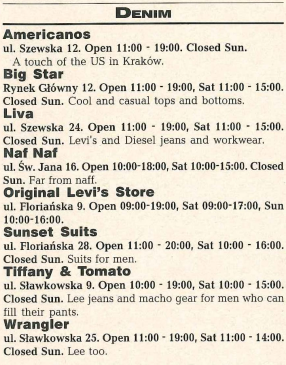
in 7 of these establishments, we were sure to list 8.
3) Keeping In Touch was Challenging and Complex
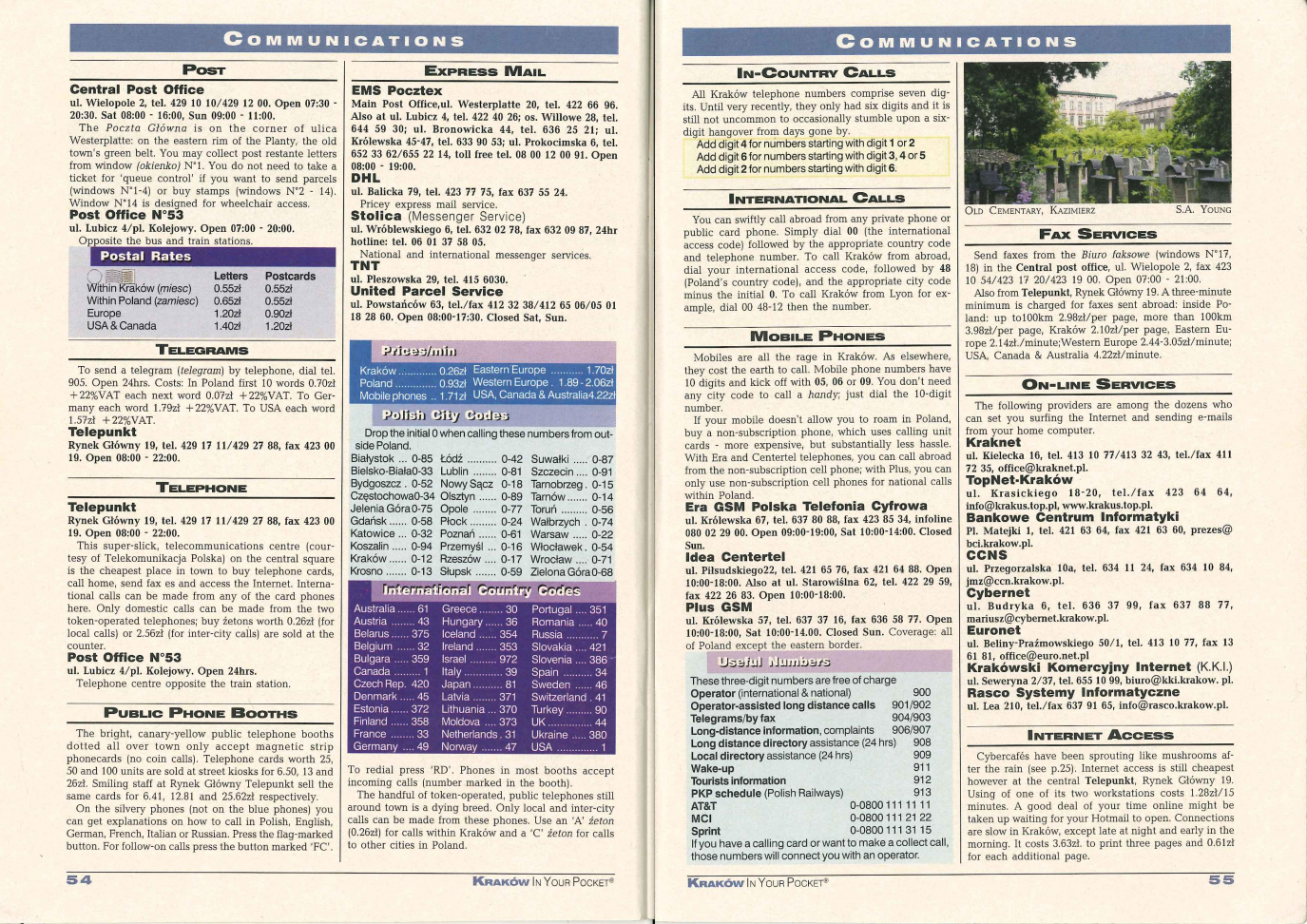
1999 was a time when pay phones, international calling cards, faxes, mobile phones (not necessarily 'smart' ones, though) and internet cafes all overlapped. Even more unbelievably, you could still send telegrams - a technology whose popularity literally peaked in the 1920s and '30s - from any Telepunkt shop or post office. Any foreigner can attest to just how much of a nightmare going to the post office for any reason was then and still is today, and the fact that they only stopped offering telegram services in 2018(!) is testament to the Polish Post Office's continuing commitment to being a bastion of backwardness.

4) Internet Cafes were Important Social Centres

the warning signs were there back in '99.
5) The Internet was Mostly used for Email
When the first guide hit stands, none of it was online yet. But you could apparently harvest over 1000 emails from the IYP website. Spambots, rejoice!
In 1999 the AP Stylebook may have still been debating how to write words like 'web sites' and 'e-mail,' but surely this colour combination was just as hideous then as it is today.
6) The IYP Subscription form!

In 1999, sending all your bank details and a 'cheque' by snail mail was completely normal. Let's also take a look at that list of pocketed destinations: Kraków was literally the 9th city to receive an IYP guide, and was further west than any of the previous destinations. The fact that there were early travel guides to places like Minsk and Kaliningrad suggests that Europe was arguably more 'open' in 1999 than it is today in 2024.
7) Full Plane, Train & Bus Timetables
IYP's founder Matthias Luefkens personally told us how proud he was of these timetables that he meticulously put together, so here they are - behold! If only air travel was as simple as looking at a connections list, showing up at the airport and buying a ticket today.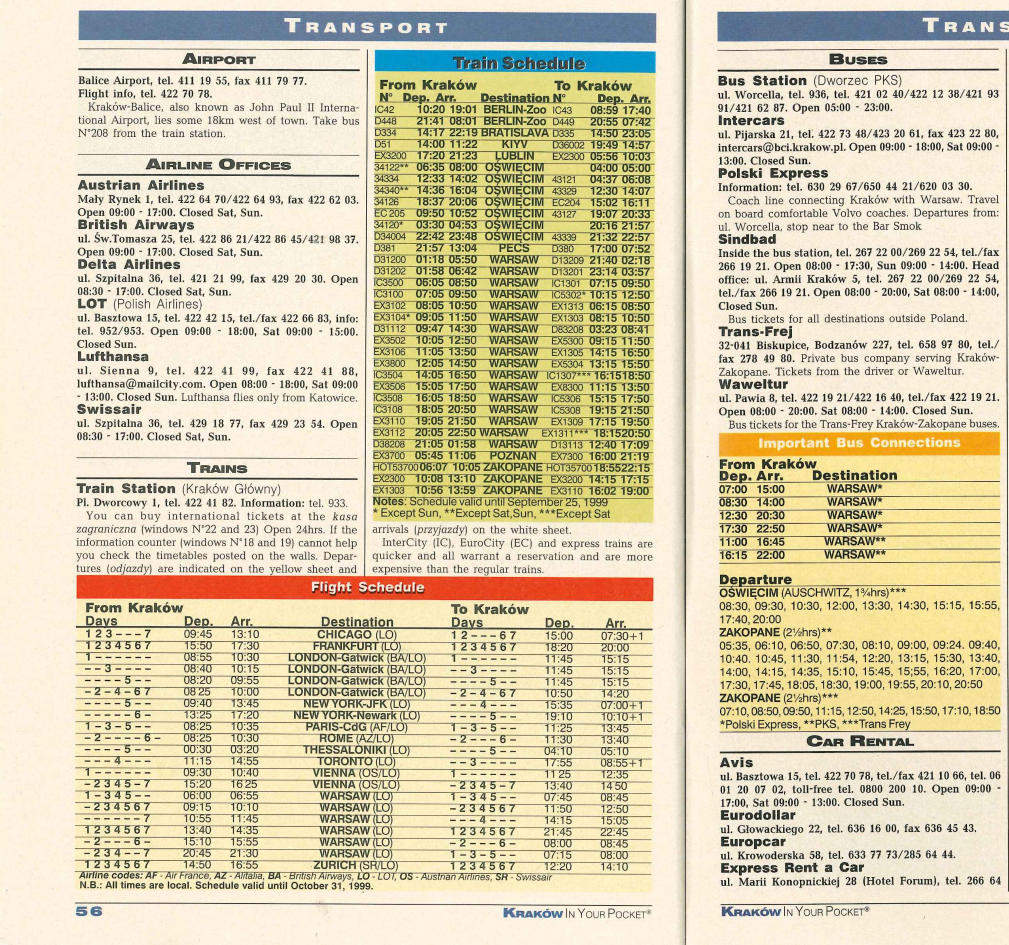
July 2024: How Things Have Changed
You can't survive 25 years in an ever-changing media landscape by resting on your laurels. While the city of Kraków has changed immensely over that period of time, so has our coverage of it. Today you'll find enough expert info and advice about Kraków on our website to power an entire workforce of AI travel agents (please feel free to harvest any 1999 data from this article, you lugnuts), and yet another design update of the site is set to be unveiled soon. Yours truly got their first smartphone explicitly to use the then-groundbreaking, now perpetually-sunsetting IYP app (technology is not only tyrannical, but fickle), and we've generated content for every social media platform we were falsely promised would make people more appreciate what we do (currently Facebook and Instagram, but we're especially proud of our newsletter (email forever!) and YouTube channel). All of which is to say, that as the technology of the travel industry, and human existence for that matter, continues to evolve, In Your Pocket continues to adapt, innovate and upgrade alongside it.
But in Poland we still print guidebooks; not just any guidebook, in fact, but the best guidebook to Kraków in existence. Take a look at this beauty.
Not only does the contemporary Kraków guide have a wider format, easier-to-read font size and much more modern design, its organisation and understanding of what kind of information is important and relevant to readers also follows a much more modern logic. Alphabetical directories have been replaced with short feature articles that help you identify what is most unique, essential and interesting so you can plan your time. Listings of nearly every known restaurant have been replaced with Kraków's most essential street foods, must-try tipples and most cherished traditional dishes, alongside suggestions for where to experience them. Superfluous shops have been replaced with information on the most representative local gifts and souvenirs. Hotels are gone, replaced with outdoor activities, seasonal attractions and art spaces worth investigating. Basically the guide trades endless minutiae that can today be easily ascertained online, for up-to-date recommendations on the absolute best places and experiences the city has to offer.


options that put you in control based on your interests.
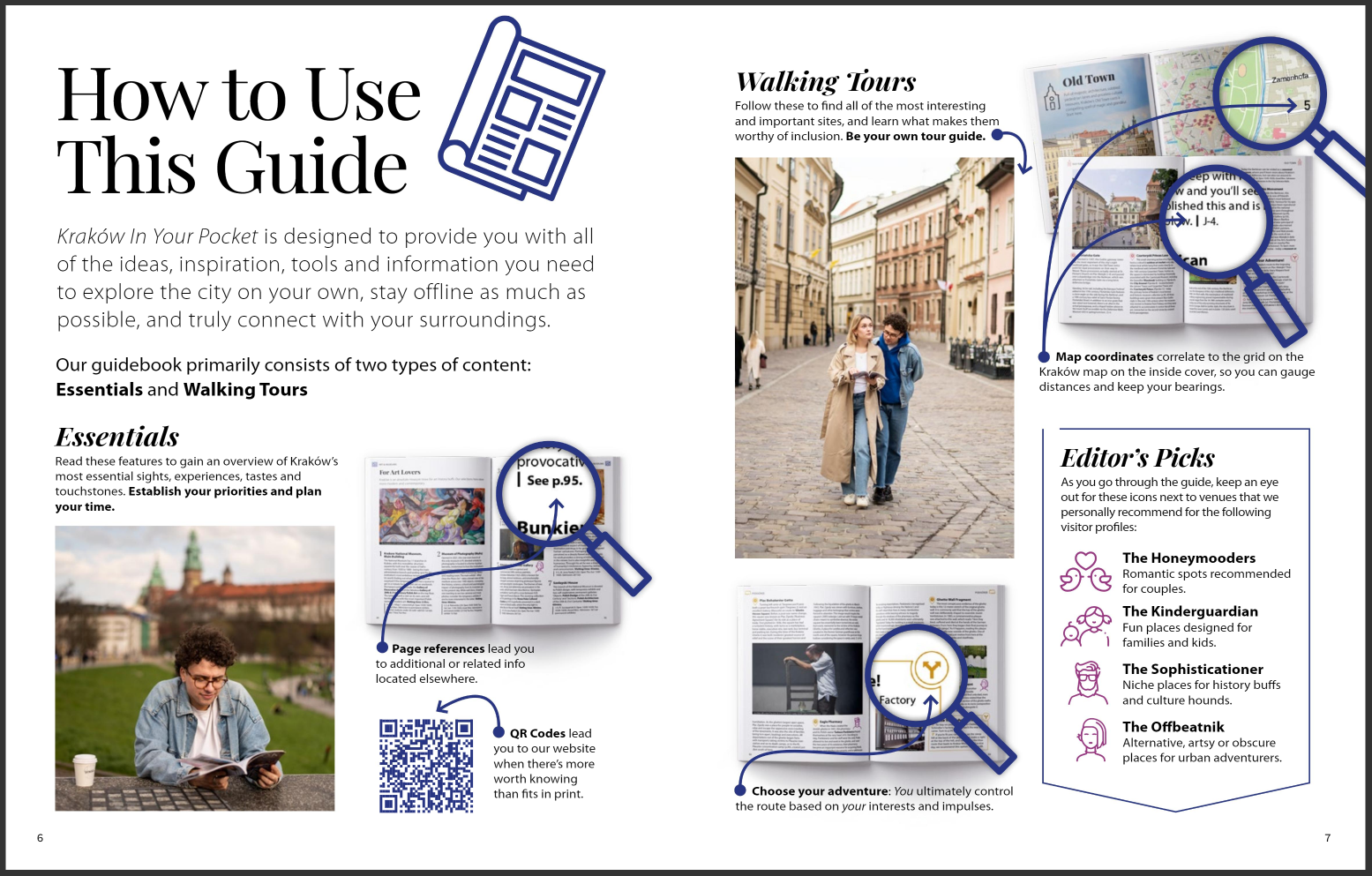
How Things Haven't Changed
While many things about our guides have certainly changed, the philosophy and values at the heart of Poland In Your Pocket have not. We still print guides, we still encourage you to use old school maps, our guides are still written by locals with a unique foreign perspective on their cities, and Kraków In Your Pocket is still free of advertorials and paid content. As the internet and its vast online resources have made the very concept of travelling with a guidebook much more niche, we've improved what we do by better understanding our own niche: independent, offline printed materials written by local humans for human travellers.
This Podgórze map shows several route options and shortcuts connecting them.
Our guides encourage you to slow down, stay offline and connect with your surroundings. They break you out of your online habits and routines and transport you back to a style of slow, immersive travel that perhaps you experienced 25 years ago. Or perhaps (in this editor's dreams) it takes you forward to a time that's coming, when people start to push back against the invasiveness of constant connectivity and start to switch off again while travelling. The entire purpose of travel is to connect with new people and places, after all, not keep in touch with the place you've left and flood it with digital fractals informing everyone of what you're up to. It's about taking yourself out of the context of everyday life and having new experiences in new environments. Arguably nothing can facilitate that better than a guidebook that gives you good local advice and reliable info, and helps you figure out how to experience the best a place has to offer without extensive prior planning and endless on-the-go research. If you want to feel the excitement of discovery that we felt when we started this company 25 years ago...we recommend you put your phone away and pick up a guidebook. It might change your life.
Get the latest issue of Kraków In Your Pocket, and start travelling offline.
You'll thank us.



Comments